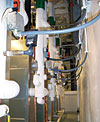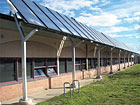
These are the six WR2-Series units from Mitsubishi Electric Cooling and Heating Solutions, installed at the Minnie Howard Middle School, Alexandria City Public Schools, Alexandria, Va. This equipment (and the technology) uses water, in conjunction with the geothermal wells, as a heat exchange medium. They can be installed inside, rather than outside a building.
ALEXANDRIA, Va. - In many ways, middle schools are inherently challenging. T.C. Williams High School’s Minnie Howard Middle School has provided Alexandria’s ninth-grade students with a successful transition from middle school to senior high school since 1993.
The 54-year-old school is dedicated to Minnie Howard, Alexandria’s first PTA president. In 2008, Alexandria City Public Schools (ACPS) hired the Leesburg, Va., offices of Hayes Large Architects LLP and B2E Consulting Engineers to help turn the Minnie Howard campus into a laboratory for testing green building technologies that could be implemented system-wide.
Hayes Large and B2E devised an innovative package of technologies to form what may be one of the most energy-efficient systems in the country. These included a combination of solar and ground-source geothermal systems to lower heating and cooling costs; a water-source variable refrigerant flow (VRF) zoning HVAC system to simultaneously cool and heat the building; water source heat pumps; solar heat exchangers; low-flow plumbing fixtures; and tubular skylights to bring sunlight into classrooms, corridors, and bathrooms.
Synchronizing all of these sophisticated technologies into one cohesive system was a challenge. B2E turned to Mitsubishi Electric Cooling and Heating Solutions, Suwanee, Ga., because it heard that the new water-source W-Series units would physically fit into the tight spaces in the mechanical room, and the VRF technology would support B2E’s aggressive profile for efficiency and sustainability.
THE PROCESS
Collections of 42 solar collector panels were placed on the front of the school to provide active solar water heating and serve as a sun shade, reducing glare and cooling costs. It is expected to reduce the school’s natural gas consumption by 66 percent. For the new geothermal system, a field of 60 wells was drilled 300 feet beneath the school parking lot.Well drilling began in April 2009. General contractor Caldwell and Santmyer Inc. of Berryville, Va., first removed the 50-year-old HVAC system that included two locomotive-sized boilers and chillers.
HVAC contractor Shapiro & Duncan Inc. of Rockville, Md., was brought in to install the six water-source zoning units located next to the back-up boilers, solar heat exchanger, and the make-up outside air unit. The contractor also set up the complex plumbing network that connected the 8,000 feet of piping that joined the geothermal closed-loop water system to the six WR2-Series Inverter-driven units.

The geothermal field at Minnie Howard Middle School where a field of 60 wells was drilled 300 feet beneath the school’s parking lot.
“The school went from having an antiquated chiller that was keeping water at 40°F, and two huge, inefficient boilers maintaining 180° water all the time (even if it wasn’t needed), to a variable-speed condensing unit coupled to a geothermal well system that only runs if an indoor air handler needs cooling or heating.

This is the PQRY piping & flow metering system for the six PQRY units of the WR2-Series systems from Mitsubishi Electric Cooling and Heating Solutions installed at the Minnie Howard Middle School, Alexandria City Public Schools, Alexandria, Va.
Ott said he was impressed with the outdoor units, which utilize water as a heat exchange medium, when used in conjunction with the geothermal wells. “It was a very logical solution for energy conservation,” he said.
“I also like the reduced cost of labor and materials needed for installation because Mitsubishi is the only two pipe system in the industry. The installation was hassle free and the system started up the very first time with no glitches. When you consider there are 8,000 feet of piping, that’s amazing.”

The latest in solar array and geothermal designs was employed at 54-year-old Minnie Howard Middle School.
RIPPLE EFFECT
The success of installation has had something of a ripple effect within the district. ACPS has proceeded to design, fund, and install similar HVAC green technology systems at three other campuses.In fact, the word has spread further than that. ACPS supervisor of design and construction David Conrath said he has been overwhelmed by the reaction of his peers throughout the Mid-Atlantic. Calls, e-mails, and requests for actual tours of the Minnie Howard facility started in March of this year.
“It’s hugely gratifying,” Conrath said, “but impossible for this ‘one-man band’ to satisfy the curiosity, respond to the inquiries, describe how we did it, and quantify the actual savings numbers.”
In addition to the energy reductions from the mechanical systems, the school is implementing a recycling program and water use initiatives. The school also plans on having a green roof in the future.
It was even recognized by the students. Demetrius Ricard and Lora Strum, freshmen and staff writers for an ACPS high school paper, stated, “Aside from the efficiency of the structure, ACPS hopes that the placement of the panels will show the community the new green mission.”
Publication date:08/02/2010

Report Abusive Comment